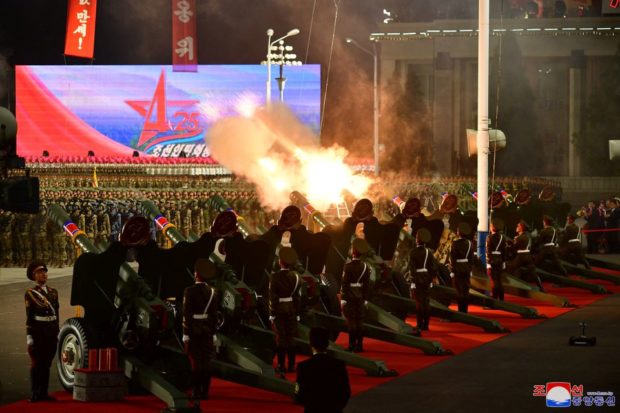
Troops perform a gun salute during the parade to mark the 90th anniversary of the founding of the Korean People’s Revolutionary Army in Pyongyang, North Korea, in this undated photo released by North Korea’s Korean Central News Agency (KCNA) on April 26, 2022. KCNA via REUTERS
SEOUL — North Korea will speed up development of its nuclear arsenal, leader Kim Jong Un said while overseeing a huge military parade that displayed intercontinental ballistic missiles (ICBMs) and other weapons, state media reported on Tuesday.
The parade occurred Monday night during celebrations for the founding anniversary of North Korea’s armed forces, state news agency KCNA said. It comes as Pyongyang has stepped up weapons tests and displays of military power amid stalled denuclearisation talks with the United States and an incoming conservative administration in South Korea.
U.S. and South Korean officials say there are signs of new construction at North Korea’s only known nuclear test site, which has been officially shuttered since 2018, suggesting Pyongyang may be preparing to resume testing nuclear weapons.
“The nuclear forces of our Republic should be fully prepared to fulfil their responsible mission and put their unique deterrent in motion at any time,” Kim told the gathering, according to KCNA.
The fundamental mission of the North’s nuclear force is to deter war, but its use “can never be confined to the single mission,” he added.
“If any forces try to violate the fundamental interests of our state, our nuclear forces will have to decisively accomplish its unexpected second mission,” Kim said.
North Korean leader Kim Jong Un watches a nighttime military parade to mark the 90th anniversary of the founding of the Korean People’s Revolutionary Army in Pyongyang, North Korea, in this undated photo released by North Korea’s Korean Central News Agency (KCNA) on April 26, 2022. KCNA via REUTERS
Hong Min, a senior fellow at the Korea Institute for National Unification in Seoul, said Kim’s speech could signal a change in his nuclear doctrine to leave open the possibility of “nuclear first use,” after previously confining their purpose to deterrence and defence.
“Though he did not specify what makes the ‘second mission’ or ‘fundamental interests’, he indicated more broadly that the nuclear force might be used preemptively, not only when they’re under attack, but also under certain circumstances,” Hong said.
Yang Moo-jin, a professor at the University of North Korean Studies in Seoul, said Kim’s remarks could have been aimed at the incoming government of South Korean president-elect Yoon Suk-yeol, who has warned of possible preemptive strikes if an attack from the North were imminent.
The transition team of Yoon, who takes office on May 10, criticized Pyongyang for building menacing weapons while appearing to pursue talks.
“The parade proved that North Korea has outwardly called for peace and dialogue over the last five years but in reality it focused on developing the means to threaten not only the Korean peninsula but Northeast Asia and world peace,” deputy spokesman Won Il-hee told a briefing.
“Securing the capability to deter North Korea’s grave and real threat is the most urgent task,” Won added, vowing to bolster the U.S. alliance and expedite weapons development to beef up Seoul’s deterrence.
The parade featured North Korea’s largest known ICBM, the Hwasong-17, KCNA reported. The massive missile was test fired for the first time last month, but officials in South Korea believe efforts to conduct a full test ended in an explosion over Pyongyang.
Multiple rocket launcher vehicles take part in a nighttime military parade to mark the 90th anniversary of the founding of the Korean People’s Revolutionary Army in Pyongyang, North Korea, in this undated photo released by North Korea’s Korean Central News Agency (KCNA) on April 26, 2022. KCNA via REUTERS
North Korea’s Rodong Sinmun newspaper released photos showing the Hwasong-17, as well as what appeared to be hypersonic missiles and submarine-launched ballistic missiles (SLBMs), among other weapons on trucks and launching vehicles rolling by crowds of flag-waving observers and participants.
The procession also included rows of conventional weapons such as artillery, rocket launchers, and prototype tanks, plus tens of thousands of goose-stepping troops shouting “long life” to Kim Jong Un.
North Korea’s ballistic missile and nuclear weapons programmes are banned by United Nations Security Council resolutions, which have imposed sanctions on the country.
In the latest weapons test on April 16, Kim oversaw the launch of what state media said were short-range missiles that could deliver tactical nuclear weapons.
On a visit to Seoul last week, U.S. envoy on North Korea Sung Kim said the allies would “respond responsibly and decisively to provocative behavior,” while underlining his willingness to engage with North Korea “anywhere without any conditions”.
North Korea has said it is open to diplomacy, but has rejected Washington’s overtures as insincere in view of what Pyongyang sees as “hostile policies” such as sanctions and military drills with the South.
RELATED STORIES
North Korea fires possible ICBM in largest test since 2017
US says North Korea testing new ICBM system
South Korea sees imminent prospect of North ICBM test – newspaper
U.S. targets Russians in new North Korea sanctions after missile launches